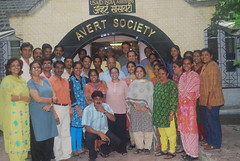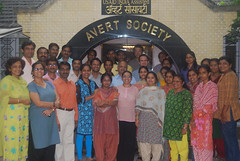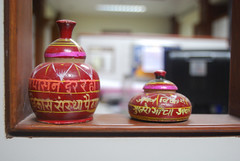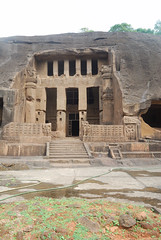 October 2nd, the last day of our stay in Mumbai. It is again a holiday: Today is Gandhi's birthday and a national holiday. We had a short wrap up meeting again with lots of gifts, even one from the hotel!
October 2nd, the last day of our stay in Mumbai. It is again a holiday: Today is Gandhi's birthday and a national holiday. We had a short wrap up meeting again with lots of gifts, even one from the hotel!
On our lunch yesterday with our client I mentioned that there are two places yet in Mumbai yet I didn't visited. The one is the Ganesha temple in Dadar, the main temple of the god in Mumbai. The other is the Kanheri Caves in the Sanjay Gandhi National Park. Our client immediately offered me the car to pick me for today afternoon to visit the caves. Dr. Raj, who lives in Borivadi, offered himself for being my guide. This is something that can only happen in such a friendly country: I mean, we have finished our work. And it is a holiday!
The Kanheri Caves are a buddhist site. It was used from the 1st until the 9th centries. It is by far not so elaborated as the Ajanta Caves and the Ellora Caves in Aurangabad, but it is still very impressive. The caves are located almost in the middle of the National Park, surrounded by green forests. They are hewn in the basaltic rock crops along a small valley. Between the caves there are steps. The early residents had also built a system of small channels and cisterns to collect and store rain water, which are surely very valuable in this high and hot place.
Since it is a buddhist site it is more familia to me than the Elephanta Caves. There are different sort of caves: Caves for the residents with caved windows and a small stone bed. Caves for worships with Buddha statues and stupas in the center place. There is one quite big cave with long stone tables that looks for me almost light a place where people gather and have meat together.
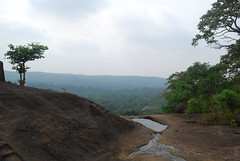 There are also a lot of differences between the composition of the big worship caves with the buddhist temples or caves in China. For example the center position of stupas. In the Chinese temples the center place are replaced by a pagoda (for temples before the 10th century) or by the central hall with Buddha statues (for temples that are build later than 10th century). Pagodas are an architecture evolution of stupas in eastern Asia. To see the original Indian buddhist site one can see how the architect evolves with the geographic position and the time.
There are also a lot of differences between the composition of the big worship caves with the buddhist temples or caves in China. For example the center position of stupas. In the Chinese temples the center place are replaced by a pagoda (for temples before the 10th century) or by the central hall with Buddha statues (for temples that are build later than 10th century). Pagodas are an architecture evolution of stupas in eastern Asia. To see the original Indian buddhist site one can see how the architect evolves with the geographic position and the time.
Especially the central big congregation hall has in its composition very big similarities with a christian church. The stupa is positioned under a big dome, on both sides of the long hall are pillars. The buddhastatues are framed with two small angels on each side. I don't know if these compositional similarities do mean that there were some influences between the two or if they are pure odd.
After the caves Dr. Raj invited me to have a tea in his home. He lives with his parents and a younger brother in a flat. They are very friendly people.
On the way back to hotel there was another event that ashamed me. As usual if you stop before a signal there are children who come to the windows of the car and beg. And as usual I just ignored her. But my driver, Arun, gave her a two Rupees piece.
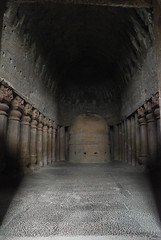 Zweiter Oktober, der letzte Tag für uns in Bombay. Es ist wieder ein Feiertag: Heute is Gandhis Geburtstag und ein Nationalfeiertag. Wir hatten einen kurzen Abschlussmeeting, wieder mit vielen Geschenken, sogar ein vom Hotel!
Zweiter Oktober, der letzte Tag für uns in Bombay. Es ist wieder ein Feiertag: Heute is Gandhis Geburtstag und ein Nationalfeiertag. Wir hatten einen kurzen Abschlussmeeting, wieder mit vielen Geschenken, sogar ein vom Hotel!
Beim Mittagsessen Gestern mit unserem Kunden erwähnte ich, dass es noch zwei Orte in Bombay gibt, die ich nicht besucht habe. Ein ist der Hauptganeshatempel in Dadar und ein ist die Kanheri Höhlen in der Sanjay Gandhi Nationalpark. Unser Kunde bot mich sofort an, heute mit dem Wagen mich abzuholen, um am Nachmittag die Höhlen zu besuchen. Dr. Raj, der in Borivadi wohnt, bot mich an mein Führer zu sein. Das ist ebenfalls etwas, das nur in einem freundlichen Land passieren kann: Immerhin ist unsere Arbeit getan und es ist ein Feiertag!
Die Kanheri Höhlen ist ein buddhistischer ort. Es wurde zwischen dem ersten und dem neunten Jahrhundert benutzt. Es ist nicht so ausgeschmückt wie die Ajanta Höhlen und die Ellora Höhlen in Aurangabad, aber immer noch sehr beeindruckend. Die Höhlen befinden sich fast in der Mitte des Nationalparks, umgeben von grünem Urwald. Sie wurden in basaltischen Felsen entlang einem kleinen Flusstal gehauen. Zwischen den Höhlen sind Treppen. Die früheren Bewohner haben auch ein System von kleinen Kanälen und Zisternen erschaffen, um Regenwasser zu sammeln und zu speichern, was sicherlich sehr wertvoll in diesem hochgelegenen und heißen Platz ist.
Da es sich um ein buddhistischen Ort handelt ist es für mich mehr vertrauter als die Elephanta Höhlen. Es gibt hier unterschiedlichen Sorten von Höhlen: Höhlen für Bewohner mit ausgemeißelten Fenstern und einem kleinen Steinbett. Köhlen für Anbetung mit Buddhastutuen und Stupas in der Mitte. Es gibt eine ziemlich große Höhle mit lange Steintafel, das für mich aussieht als würden die Leute hier versammeln und zusammen Essen einnehmen.
 Es gibt auch viele Unterschiede zwischen den Kompositionen der großen Anbetungshöhlen mit buddhistischen Tempel oder Höhlen in China. Zum Beispiel die zentrale Position der Stupa. In chinesischen Tempel nimmt ein Pagoda (für Tempel vor dem 10ten Jahrhundert) oder die große Halle mit Buddahstatuen (für Tempel nach dem 10ten Jahrhundert) den zentralen Platz ein. Pagoden sind architektonischen Evolution der Stupa in Ostasien. Ein original indische buddhistische Ort zu besuchen ist sehr interessant da man die architektonische Entwicklung zwischen Orten und Zeiten studieren kann.
Es gibt auch viele Unterschiede zwischen den Kompositionen der großen Anbetungshöhlen mit buddhistischen Tempel oder Höhlen in China. Zum Beispiel die zentrale Position der Stupa. In chinesischen Tempel nimmt ein Pagoda (für Tempel vor dem 10ten Jahrhundert) oder die große Halle mit Buddahstatuen (für Tempel nach dem 10ten Jahrhundert) den zentralen Platz ein. Pagoden sind architektonischen Evolution der Stupa in Ostasien. Ein original indische buddhistische Ort zu besuchen ist sehr interessant da man die architektonische Entwicklung zwischen Orten und Zeiten studieren kann.
Besonders der große Versammlungshalle ähnelt in seine Komposition eine christlische Kirche. Die Stupa wird unter eine große Kuppel platziert, auf beiden seiten der langen Halle sind Säulen. Die Buddhastatuen sind von zwei kleinen Engeln auf beiden Seiten umgeben. Ich weiß nicht ob diese kompositorischen Ähnlichkeiten Zufall sind oder ob es tatsächlich Einflüssen zwischen den beiden gegeben haben.
Nach der Höhlen lud mich Dr. Raj für ein Tee nach Hause ein. Er lebt mit seinen Eltern und ein jüngerer Bruder in eine Wohnung. Sie sind alle sehr freundlichen Menschen.
Auf dem Weg zurück zum Hotel hatte ein Ereignis mich wieder beschämt. Wie gewöhnlich wenn man an eine Kreuzung vor einem Ampel halt macht kommen Kindern zum Betteln. Wie immer ignoriere ich sie. Aber mein Fahrer, Arun, gab sie ein zwei Rupees Stück.
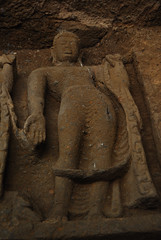 十月二日,我们在孟买的最后一天。今天又是节日:今天是甘地的生日,印度的国家节日。 我们开了一个短短的结束会议。又有许多礼物,甚至旅店也送了一份!
十月二日,我们在孟买的最后一天。今天又是节日:今天是甘地的生日,印度的国家节日。 我们开了一个短短的结束会议。又有许多礼物,甚至旅店也送了一份!
昨天我们和顾客一起吃午饭的时候我提到在孟买我还有两个地方没有趣。一个是位于Dadar的格涅沙主庙,另一个是位于桑贾伊·甘地国家公园的Kanheri石窟。我们的顾客立刻派车今天下午带我去参观石窟。住在Borivali的Raj大夫也愿为我做导游。这样的事情也只会在一个好客的国家发生:我们的工作已经完成,而且今天是节日!
Kanheri石窟是一个佛教遗址。它是从一至九世纪开琢的。它虽然远没有阿旖陀石窟和埃洛拉石窟那样华丽,但依然非常可观。这些石窟几乎位于国家公园的中心,被绿色的森林环绕。它们是在一条小河谷两边的火成岩岩石上刻出的。在石窟之间有石阶相连。当时的居民还刻凿了小管道和水池来收集和储藏雨水。在这个位置比较高而且很热的地方水肯定非常宝贵。
因为这是一个佛教遗址,因此我对这里比对象岛石窟要熟悉些。这里有不同的石窟:有的是住的,有石头琢出来的窗和石头床。有的是庙宇,在其中心佛像或者窣堵坡。有一个比较大的石窟里面有很长的石桌,看上去像是聚集吃饭的地方。
 这个石窟里的庙宇与中国的佛教庙宇和石窟有许多差别。比如在这里窣堵坡拥有中心地位。在中国的庙宇里塔(10世纪前)或者大雄宝殿(10世纪后)拥有中心地位。塔是窣堵坡在东亚的建筑演化。看到印度的佛教地址可以看出建筑在空间和时间的变化。
这个石窟里的庙宇与中国的佛教庙宇和石窟有许多差别。比如在这里窣堵坡拥有中心地位。在中国的庙宇里塔(10世纪前)或者大雄宝殿(10世纪后)拥有中心地位。塔是窣堵坡在东亚的建筑演化。看到印度的佛教地址可以看出建筑在空间和时间的变化。
尤其最大的石窟在布局上与基督教的教堂有许多类似的地方: 窣堵坡位于一个拱顶下面。长殿两边有石柱。在佛像两侧有两个小天使。我不知道这些类似之处是偶然的还是两者之间有一定的相互影响。
参观石窟后Raj大夫还请我到他家里去喝茶。他和父母以及一个弟弟一起住。他们都很友好。
在回旅店的路上发生的一件事情又使我很窘迫。在红灯前等的时候总会有小孩子来要钱。我一般都不理他们。但是我的司机Arun给了她一枚两卢比的硬币。
